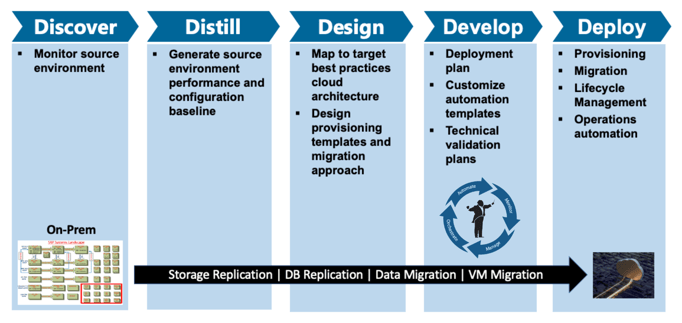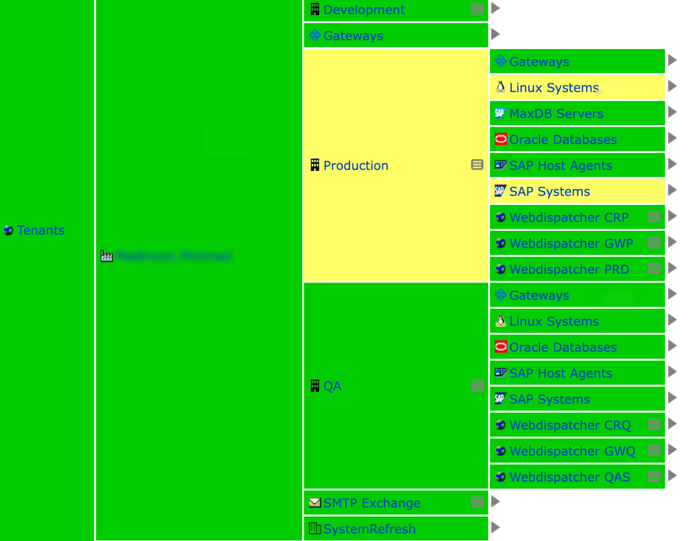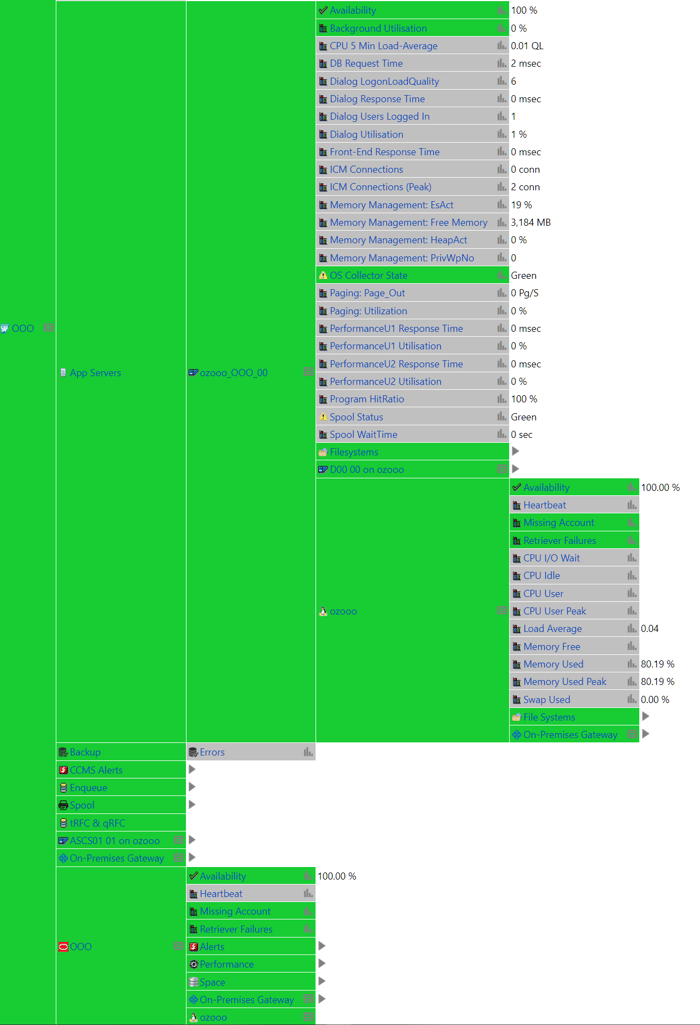Cloud migration might seem like simply moving resources from physical infrastructure to a virtual environment. However, in reality, it involves a wide range of considerations and approaches. While the basic idea is to shift from on-premises systems to the cloud, the process is far from straightforward. Migration can involve transitioning to a private cloud, a public cloud, or a hybrid setup—each with its own complexities. It's also important to note that while virtualization can exist without cloud computing, cloud computing cannot function without virtualization.
Virtualization and cloud computing are often used interchangeably, which can make understanding cloud migration more confusing without first distinguishing between the two. To simplify the discussion, let's focus on public cloud migration, where infrastructure is managed by cloud service providers like Amazon Web Services (AWS), Microsoft Azure, and Google Cloud.
5Ds of IT-Conductor's Cloud Migration Strategy
IT-Conductor Migration Process
Discover Source Application Environment
Distill Source Application Environment
Design Target Cloud Infrastructure
Develop Target Cloud Infrastructure
Deploy Application Components in Target Environment
5Ds of IT-Conductor's Cloud Migration Strategy
Migrating to the cloud involves moving applications, data workloads, and other digital assets required to run your business. This makes it crucial to develop a well-thought-out strategy for your cloud journey. Last year, we emphasized the importance of developing your cloud-first strategy. In this post, we’ll shift our focus to the technical aspects by breaking down the 5Ds of IT-Conductor's Cloud Migration Strategy and exploring how each stage can support a smooth and successful transition to the cloud.
IT-Conductor Migration Process
Migrating applications and databases to the cloud requires understanding the source environment, generating a baseline for its configuration and performance, designing and developing the target infrastructure in the cloud, deploying application components in that target environment, and finally validating the success of the migration.
Discover Source Application Environment
Understanding the source application environment goes beyond simply identifying the source, as you might in a traditional client-server network. It requires in-depth knowledge of specific application domains, including how multiple interrelated applications interact, integrate, and depend on one another. It also involves evaluating the security controls that govern these integrations and ensuring secure access for end users across the system.
The rise of multi-tenant database management systems adds another layer of complexity to application discovery. Because these systems support multiple isolated databases within shared resources, understanding the source application environment becomes more challenging. For example, SAP HANA’s multi-container architecture includes multiple servers, such as nameservers and index servers, and each database runs different instances of these servers. Without specialized tools to connect and visualize all the components, discovering and mapping the full system landscape can be a daunting task.
As an application performance management (APM) platform, IT-Conductor uses a multi-layered approach to automatically discover deep dependency chains between components. Despite the complexity and dynamic nature of source application environments, the platform efficiently discovers all components and presents them in a clear, hierarchical view.
Distill Source Application Environment
Once the source application environment is understood and discovered, the next step is to establish performance and configuration baselines. Performance baselines consist of key metrics aligned with your business goals. For example, if your primary objective in migrating to the cloud is to improve the end-user experience, you should focus on baselines like typical application response times. Other important performance baselines include resource utilization metrics such as CPU and memory usage, storage capacity, and network throughput.
Aside from these performance metrics, you also need snapshots of the last working configuration state of your source application environment. This way, it will be easier for you to revert to its last-known good state should issues arise during the deployment stage.
It’s also important to understand the distinction between identifying the “true” state of resources based on both performance and configuration baselines. For instance, a component being temporarily unavailable doesn’t always indicate system failure. There may be redundancies in place or misconfigured heartbeat settings.
Unlike registry-based discovery, which offers limited visibility and requires constant manual updates, APM-based discovery dynamically reflects real-time changes in status and configuration. This makes it especially valuable during migration, allowing you to proactively detect issues before and during execution. If unexpected problems occur, your baselines become a critical reference point, helping you fine-tune the environment or revert to a stable state quickly.
Design Target Cloud Infrastructure
There are multiple scenarios to consider when migrating resources to the cloud, and each cloud service provider offers its own approach and strategy.
In November 2016, Stephen Orban introduced AWS's 6Rs model—mainly Rehosting, Replatforming, Repurchasing, Refactoring, and Retire—as key strategies for cloud migration. Since then, the AWS Services Team has expanded on this model, incorporating new services and enhancements to support a broader range of migration needs, now offering seven strategies for migrating applications to the cloud.
Meanwhile, Microsoft Azure follows the Cloud Adoption Framework. Google Cloud takes yet another path, emphasizing a phased process that begins with workload discovery and assessments and continues through deployment and ongoing optimization in the cloud..
Regardless of the migration approach you choose, the complexity of your deployment will typically fall into one of three main scenarios:
- Manual - makes use of human-readable data such as spreadsheets and reports
- Assisted - makes use of pre-defined workflows generated using Terraform, Ansible, and/or cloud-specific templates, and still requires manual effort to further refine existing templates and best suit the source application environment
- Full Automation - automated inference and analysis of the target cloud environment.
Opting for a manual cloud migration isn’t necessarily a bad choice. In some cases, it may be the most suitable approach for your specific needs. However, if you’ve firmly decided to proceed without the use of automation or orchestration tools, the next stages outlined in this post may not apply directly to your situation. That said, if there’s even a slight uncertainty—say, 1% doubt—about going fully manual, exploring the following stages may help you uncover alternative options worth considering.
Develop Target Cloud Infrastructure
The rollout of the target infrastructure is driven by the outcomes of the design stage. Once you've defined your migration approach—whether manual, assisted, or fully automated—the next step is to begin the actual build-out. The following migration scenarios, however, focus specifically on developing the target infrastructure using automation:
- Assisted
- Pre-defined workflows defined in the design stage are refined to best suit the source application environment.
- Managed
- Pre-defined workflows are to be executed by an orchestration tool, where the execution is monitored in the backend.
- You can configure notifications depending on how you want to get alerted when errors occur.
- The orchestration tool is also capable of storing logs for root-cause analysis and compliance audits.
- Full Automation
- The target environment is rolled out automatically based on the design parameters.
- The resulting cloud infrastructure is seamlessly incorporated into the APM monitoring environment.
- No manual intervention. Stages in workflows are triggered automatically upon completion of previous activities.
Deploy Application Components in Target Environment
At this stage, you should be ready to deploy application components into the cloud infrastructure that was provisioned in the previous step.
- Assisted
- Pre-defined workflows defined at the prior stages are executed by an administrator.
- Managed
- Pre-defined workflows are created during earlier stages and executed by the orchestration tool.
- Administrators receive alerts immediately if any issues arise during execution.
- After completion (or if a problem occurs), administrators can review detailed logs to diagnose and resolve the issue.
- Full Automation
- Components are deployed according to the design blueprint created in earlier stages, effectively replicating the source application environment.
- Monitoring of the newly deployed cloud environment begins seamlessly immediately after deployment, ensuring continuous visibility and performance tracking.
Depending on your requirements, you can choose to use an orchestration tool (assisted, managed, or full automation) to execute the migration seamlessly without any impact on end-users.
Validate Performance Assessment
The validation stage takes place upon the completion of the migration activity. It’s crucial to execute a performance assessment because it helps you evaluate the readiness of your systems in the cloud. To fully assess the success of cloud migration from the performance perspective, you should perform the following:
Load Testing
Load testing is a subtype of performance testing that measures system response under extreme load conditions. It is performed to simulate multiple users accessing the system and test its limits to evaluate if the system is capable of handling real-world scenarios.
Analyze SLOs
Service Level Objectives (SLOs) also help define migration success, as they help you measure what is expected from your systems after the migration activity.
Compare Baselines
Measure performance metrics in the new environment over time. Then analyze and compare with baselines defined at the prior stages. Make sure they are behaving in accordance with the defined SLOs.
IT-Conductor as a Cloud Migration Solution
Cloud migration is shaped entirely based on the following questions:
-
Why are you moving to the cloud?
-
What are you trying to accomplish?
-
How are you going to do it?
-
How will you measure your success?
Depending on your business objectives and chosen migration strategy, selecting the right tool is essential to achieving your goals. While cloud service providers offer a range of tools to simplify migration, the reality is often more complex. With each tool serving a specific purpose, the process can become overwhelming—and costly. That’s why using a third-party solution isn’t a compromise, but a strategic advantage. An integrated platform can not only streamline cloud migration but also provide robust performance management post-migration.
IT-Conductor, for instance, has helped partners and organizations transition smoothly to the cloud while maintaining continuous monitoring through its agentless technology—ensuring both operational visibility and efficiency.
As you plan your cloud migration journey, choosing the right tools and approach can make all the difference—not just in getting to the cloud, but in thriving once you're there.





